ARTICLE
2
Comparative Analysis - The US M17 Series and Its Copies

_____In
the late 1950s, the US Army designed and standardized
the ABC-M17 Chemical-Biological Mask. This mask was the
first to incorporate dual filter elements housed in two
bilateral cheek pockets. This feature eliminated certain
difficulties with head mobility and also enabled both
right and left handed weapon sighting. The one major drawback
however, was that the two internal filter elements were
not easily exchanged in the field. To swap filters the
wearer had to remove the mask and perform the rather difficult
and time consuming task of both extracting the spent filters
and inserting fresh ones. This is one of the key factors
that lead to the replacing of the M17A2 series masks in
the early 1990s. Despite this problem, the M17 was just
as successful as it's predecessor, the M9A1. The M17 was
copied by at least 4 countries, possibly more. |
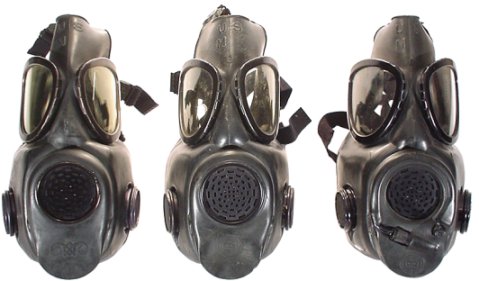
THE
US M17 SERIES (FROM LEFT): EARLY MANUFACTURED M17 (1958),
THE ABC-M17, THE M17A1/A2 |
| _____The
first prototypes of the M17 were made in the late 1950s,
and the M17 was standardized in 1959. The early version
of the M17 (above left) is possibly a prototype, considering
the date stamp of 1958 and the presence of the C.W.S. symbol
molded into the front of the mask (see below left). The
M17 went through two revisions. In 1966, the M17 was upgraded
to the M17A1 after the addition of optical insert supports,
a drinking device and a resuscitation tube. The M17A1's
drinking device was a smart mechanism that allowed a canteen
to be attached to a tube outside the mask. The canteen could
then be inverted so that the thirsty soldier could suck
water in via an angled straw on the inside of the mask.
The straw could be moved toward the wearer's lips via a
small knob on the front of the mask (see below right). The
ability to consume liquids while wearing a gas mask soon
became a standard once it was established that it could
be done. While the idea of performing CPR between two masked
soldiers was novel, the resuscitation tube that was issued
with the M17A1 proved to be complicated and often jeopardized
the integrity of the mask's airtight seal. The resuscitation
tube was eventually phased out, with the standardization
of the M17A2 in 1983. In addition to the deletion of the
resuscitation tube, a size extra small (XS) was added. Aside
from these two changes, the M17A1 and M17A2 remained structurally
identical. |
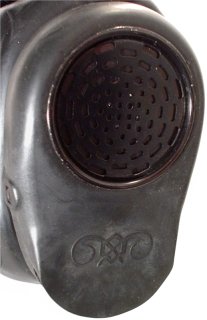
CLOSE-UP - THE FRONT OF THE EARLY M17 |
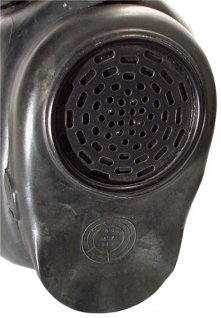
CLOSE-UP - THE FRONT OF THE STANDARD M17 |
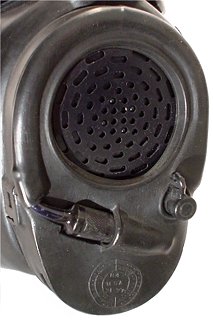
CLOSE-UP - THE FRONT OF THE M17A1/A2 |
| _____The
closest copy of the M17 was manufactured by Poland
(below, 2nd from left), and designated the MP-4M. The
face blank mold, head strap configuration, intake caps,
and exhale valve/voicemitter assembly were all virtually
identical. Only the color and mold markings are different.
Another copy, the Bulgarian PDE-1 (below left), was
also very close in design to the original US M17. However,
it used a rubber head harness and a different exhale
valve system. On the US M17, exhalation was directed
downward through the bottom of the mask via four slots
in the rubber exhale valve cover, while the PDE-1 directed
expired air through a valve on the front of the mask
which was protected by a threaded metal cap. This method
was also used on the Czechoslovakian M10 (below, 2nd
from right). The Czech M10, yet another close copy
of the M17, was later replaced by the widely distributed
M10M. The Czech M10M is the only known copy to incorporate
a drinking system. The M10M's drinking tube was configured
much differently than the US M17A1/A2 (see comparative
view below), but worked in basically the same way.
A nice feature of the M10M's drinking tube is that
it was considerably longer than that of the M17A1/A2
giving the wearer more freedom when attaching the canteen.
Perhaps the most interesting aspect of the M10M copy
is that it used a single hard plastic cap to cover
the exhale valve/voicemitter/drinking assembly instead
of a molded rubber cover like the M17A1/A2. The M10M
was issued in large numbers in both Czechoslovakia
and East Germany and is quite common on the surplus
market today. At least one other M17 copy was made
in Japan (not shown). Like the Polish version, the
Japanese version was very close in design to the original
M17. However, the Japanese version was made of green
rubber, and the intake valve caps were similar to those
used on the Czech M10 and the Bulgarian PDE-1. |
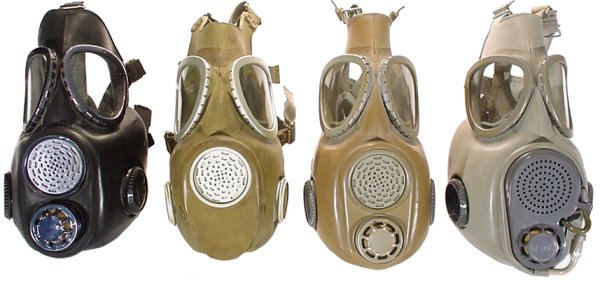
M17 COPIES (FROM LEFT): THE BULGARIAN PDE-1, THE POLISH
MP-4M, THE CZECH M10, THE CZECH M10M |
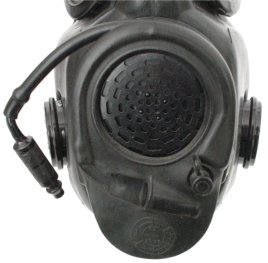
THE US M17A1/A2'S DRINKING TUBE |
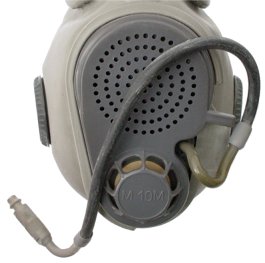
THE CZECH M10M'S DRINKING TUBE |
| _____The
M17 and all of its copies used dual filter elements,
often referred to as "pork chop" filters, due to their
shape (see below). These "pork chop" filters
were all held in cheek pockets in the same way for all
of the M17 masks and the copies. However, all of the different
filters were kept in position by inlet valve caps that
were attached from the outside of the mask, either by snapping
on or screwing directly into the filter elements. Because
these caps are all different and because the position of
the openings in the filter elements are slightly different
for all of the masks, the filters are not interchangeable
among the different M17 type respirators. |
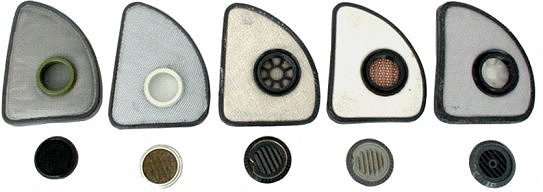
PORK CHOP FILTERS (FROM LEFT): US, POLISH, BULGARIAN,
CZECH (M10), CZECH (M10M) |
| _____As
for accessories, the M17 series mask came with a butyl rubber
hood that covered the wearer's head, neck and shoulders
(below left), a water proofing bag and a pair of eye lens
outserts. The eye lens outserts were attached over the eye
pieces after the butyl hood was in place (below left). The
M17A1 used the same setup but also included the resuscitation
tube. The Czech versions also came with protective rubber
hoods and eye lens outserts and it is likely that the other
copies came with similar hoods as well. |
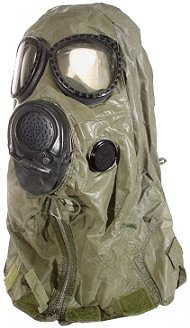
M17A1 FITTED WITH PROTECTIVE HOOD AND EYE LENS OUTSERTS |
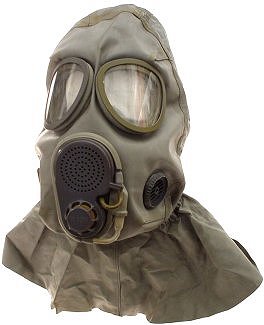
M10M FITTED WITH PROTECTIVE HOOD AND EYE LENS OUTSERTS
|
| _____Overall,
the US Army M17 Chemical-Biological Mask proved to be
influential in respirator design technology, as it was
copied in Czechoslovakia, Poland, Bulgaria, Japan and
possibly in Taiwan. Despite the success of the M17, the
M17A2 was finally phased out and replaced by the US Army
M40 in the mid 1990s during the final stages of the Gulf
War. |
© NO FUTURE PRODUCTIONS
|
|